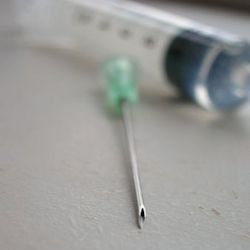Needlestick/Sharps Injury Recording Criteria
You must record all work-related needlestick injuries and cuts from sharp objects that are contaminated with another person's blood or other potentially infectious material (OPIM) as defined by 29 CFR 1910.1030. Enter the case on the OSHA 300 Log as an injury (Column (M)(1)).

To protect the employee's privacy, you may not enter the employee's name on the OSHA 300 Log (see the requirements for privacy cases in paragraphs 1904.29(b)(6) through 1904.29(b)(9))
The term "other potentially infectious materials" is defined as:
- human bodily fluids, tissues and organs; and
- other materials infected with the HIV or hepatitis B (HBV) virus such as laboratory cultures or tissues from experimental animals.
Do I have to record all cuts, lacerations, punctures, and scratches?
- No, you need to record cuts, lacerations, punctures, and scratches only if they are work-related and involve contamination with another person's blood or other potentially infectious material. If the injury is later diagnosed as an infectious bloodborne disease, you must also update the description to identify the infectious disease and change the classification of the case from an injury to an illness.
What about splashes or exposure to OPIM without being cut or scratched?
You need to record such an incident on the OSHA 300 Log as an illness if:
- It results in the diagnosis of a bloodborne illness, such as HIV, hepatitis B, or hepatitis C; or
- It meets one or more of the recording criteria in 1904.7.
NOTE: If you have a sharps exposure incident that is not a needle stick, you must still record it if it results in death, days away from work, restricted work or transfer to another job, medical treatment beyond first aid, loss of consciousness, or diagnosis of a significant injury or illness, such as HIV, hepatitis B, or hepatitis C.
Knowledge Check Choose the best answer for the question.
4-6. Record cuts, lacerations, punctures, or scratches on the OSHA 300 Log as an injury if _____.
You forgot to answer the question!
